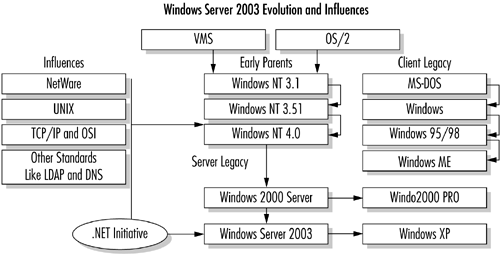|
|
|
The fundamental difference between Windows Server 2003 and its predecessor Windows 2000 resides in its embrace of the Microsoft .NET framework. While .NET is explored later, it can be safely stated that this framework helps propel the Windows environment into a transparent Internet services–based operating system. Yes, Windows Server 2003 includes hundreds of other operating system enrichments...but it is the .NET Framework enhancements that shift the paradigm from a classic client/server environment to an Internet services orientation. Microsoft has carefully crafted a computing environment that borrows heavily from earlier operating systems while adding an enhanced front-end, advanced features, and numerous administrative tools. The operating system incorporates some of the best functional elements of UNIX, NetWare, VMS, DOS, and OS/2 while providing a uniquely Microsoft interface. To a very large extent, Microsoft has succeeded in producing a robust environment that captures the best of older technologies while leveraging the new way of Internet services.
The history of Windows Server 2003 is short, but its lineage can be traced back over two decades. Windows Server 2003 is built on Windows NT technology and its formal history began in 1993. At that time, Microsoft had recently parted company with IBM on OS/2 and decided to change directions. The first released version of Windows NT was widely viewed as a curious little network operating system (NOS) designed as an alternative to IBM's OS/2 LAN Manager. However, Microsoft had bigger plans than what was perceived by early industry naysayers. The first upgrade came a year later as version 3.5 and offered many significant improvements in performance and functionality. Microsoft then upstaged itself with the release of Windows 95, and Windows NT was relegated to the back burner. The 1995 release of Windows NT 3.51 added to the networking functionality and offered a greatly enhanced suite of server products known as BackOffice. With this release, Microsoft became a serious threat to NOS vendors like Novell.
Since its release in late 1996, Windows NT 4.0 has experienced significant market acceptance. The most important advancement made with the release of Windows NT 4.0 is the incorporation of the Windows 95 user interface (UI). In fact, Microsoft internally referred to NT 4.0 as the Shell Update Release (SUR), referring to the Windows 95 front end. (By contrast, Windows Server 2003 might be considered the Internet services update to Windows 2000.) In addition to a UI, Windows NT 4.0 added the Distributed Common Object Model (DCOM) and enhanced Domain Name Server (DNS) support for its TCP/IP transport. Moreover, a great number of components—in particular, the Exchange Server—were added to the optional BackOffice suite.
Despite its many enhancements and solid sales, Windows NT 4.0 was criticized for a number of real and perceived shortfalls, especially within larger enterprise environments. Windows 2000 was designed to overcome these shortfalls with a product family to meet the needs of environments ranging from workgroups to the largest enterprises. Windows Server 2003 expands on this targeted market.
Windows 2000 was more than a renaming of the next version of Windows NT. Significant changes revolved around the new server domain architecture, inclusion of Active Directory, and vastly enhanced networking and security features. Although Windows 2000 was originally slated to be released as Windows NT 5.0 to mark a significant OS upgrade, Windows XP and Windows Server 2003 might be regarded as something closer to Windows NT 5.5. Although many enhancements and new features are available in Windows Server 2003, it remains faithful to the basic Windows 2000 design and architecture. Windows 2000 system administrators will find adopting Windows Server 2003 relatively easy.
Figure 1.1 shows the history of and influences on Windows Server 2003.

|
|
| Top |